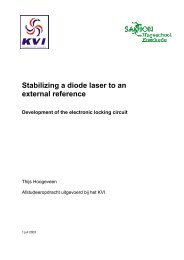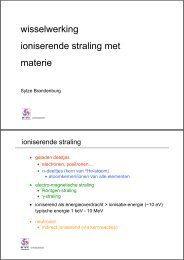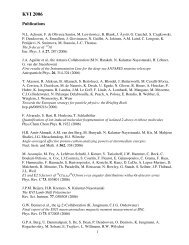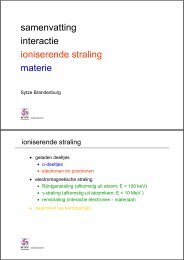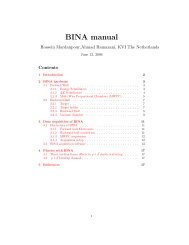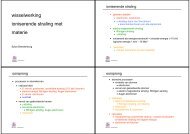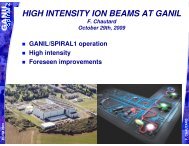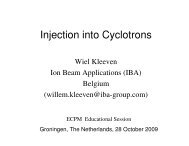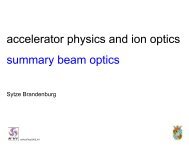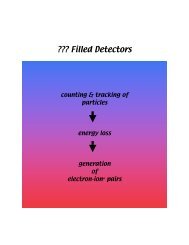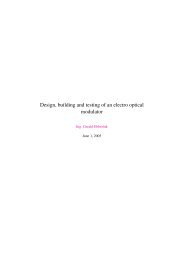Atomic parity non conservation; the francium project - KVI
Atomic parity non conservation; the francium project - KVI
Atomic parity non conservation; the francium project - KVI
You also want an ePaper? Increase the reach of your titles
YUMPU automatically turns print PDFs into web optimized ePapers that Google loves.
<strong>Atomic</strong> <strong>parity</strong> <strong>non</strong> <strong>conservation</strong>; <strong>the</strong><br />
<strong>francium</strong> <strong>project</strong><br />
SSP2012 June 2012<br />
Luis A. Orozco<br />
Joint Quantum Institute, Department of<br />
Physics<br />
University of Maryland and NIST, USA
Thanks to:<br />
Dima Budker (Berkeley)<br />
Anne Marie Bouchiat (ENS Paris)<br />
Roberto Calabrese (Ferrara)<br />
Sidney Cahn (Yale)<br />
David DeMille (Yale)<br />
Andrei Derevianko (Reno)<br />
Victor Flambaum (New South Wales)<br />
Gerald Gwinner (Manitoba)<br />
Klaus Jungmann (<strong>KVI</strong>)<br />
Mariana Safranova (Delaware)
Gwinner
Gwinner
Gwinner
Gwinner
Safranova
Safranova
Weak charge of 133 Cs<br />
Agreement with <strong>the</strong> Standard Model<br />
Experiment: Wood et al. (1997); Bennett and Wieman (1999) (Boulder group)<br />
Theory: S.G. Porsev, K. Beloy, A. Derevianko Phys. Rev. Lett. (2009)<br />
Derevianko<br />
9
Bigger picture (running)<br />
S. G. Porsev, K. Beloy and A. Derevianko, Phys. Rev. Lett. 102, 181601<br />
(2009)<br />
S. G. Porsev, K. Beloy and A. Derevianko, Phys. Rev. D 82, 036008 (2010)<br />
Derevianko
Safranova
The Yb PV Experiment<br />
Electric and magnetic fields define handedness<br />
Budker
Yb PV Amplitude Results (Berkeley)<br />
Budker<br />
ζ/β=39(4) stat. (5) syst. mV/cm ⇒ |ζ|=(8.7±1.4)×10 -10 ea 0<br />
Accuracy is affected by HV-amplifier noise, fluctuations of<br />
Accuracy<br />
stray fields,<br />
is affected<br />
and laser<br />
by HV-amplifier<br />
drifts → improved<br />
noise, fluctuations<br />
for <strong>the</strong> next<br />
of<br />
phase<br />
stray<br />
fields, and laser drifts → improved for <strong>the</strong> next phase
Parity Non<strong>conservation</strong> in Dy<br />
• Theory (1994):<br />
• H w = 70 ± 40 Hz<br />
• V. A. Dzuba et al. Phys. Rev. A 50, 3812 (1994)<br />
• Experiment (1997):<br />
• |H w | = | 2.3 ± 2.9 (statistical) ± 0.7<br />
(systematic) |<br />
• A. T. Nguyen et. al. Phys. Rev. A 56, 3453 (1997)<br />
• Improved <strong>the</strong>ory (2010):<br />
• H w ≈ 2 Hz<br />
• V. Dzuba and V. Flambaum (http://arxiv.org/abs/1001.1184)<br />
Budker<br />
14
Jungmann<br />
Single ion work in Ra + at <strong>KVI</strong>
Jungmann
Using molecules to get at NSD-PNC<br />
• Diatomic molecules systematically have close rotation+hyperfine<br />
levels of opposite <strong>parity</strong>--B-field tuning can give ΔE ~ 10 -11 eV!<br />
[Sushkov, Flambaum, Sov. Phys. JETP 48, 608 (1978), Flambaum, Khriplovich, Phys. Lett.<br />
A 110, 121 (1985) Kozlov, Labzowsky, & Mitruschenkov, JETP 73, 415 (1991)]]<br />
Cahn, DeMille
|B><br />
|A><br />
Strategy to detect PNC in near-degenerate levels<br />
H =<br />
A<br />
A<br />
(<br />
0 iH W<br />
+ dE<br />
)<br />
B !iH W<br />
+ dE "<br />
B<br />
A !(T ) 2 "<br />
= 4sin 2 !T<br />
$<br />
# 2<br />
%(<br />
' (1or2) H W<br />
*<br />
&)*<br />
!<br />
Weak Term<br />
Odd in E<br />
D. DeMille, S.B. Cahn, D. Murphree, D.A. Rahmlow, and M.G. Kozlov<br />
Using molecules to measure nuclear spin-dependent <strong>parity</strong> violation<br />
Phys. Rev. Lett. 100, 023003 (2008)<br />
Cahn<br />
dE 0<br />
+ " dE 0<br />
$<br />
" # "<br />
Stark Term<br />
Even in E<br />
%<br />
'<br />
&<br />
2<br />
+<br />
-<br />
,-
FrPNC Collaboration<br />
Approved experiments at TRIUMF S1010, S1065, S1218<br />
Seth Aubin; College of William and Mary, USA.<br />
John A. Behr, K. Peter Jackson, Matt R. Pearson, Michael Tandecki;<br />
TRIUMF, Canada.<br />
Victor V. Flambaum; University of New South Wales, Australia.<br />
Eduardo Gómez, Maricarmen Ruiz; Universidad Autónoma de San<br />
Luis Potosí, México.<br />
Gerald Gwinner SPOEKESPERSON Robert Collister, Andrew<br />
Senchuk; University of Manitoba, Canada.<br />
Dan Melconian; Texas A&M, USA.<br />
Luis A. Orozco, Jiehang Zhang, Young Shing, Gary Cheng; University<br />
of Maryland, USA.<br />
Gene D. Sprouse; SUNY Stony Brook, USA.<br />
Yanting Zhao; Shanxi University, Taijuan, China.<br />
Work supported by NSERC from Canada, DOE, and NSF from <strong>the</strong> USA.
TRIUMF:<br />
John Behr<br />
University of Manitoba<br />
Mat<strong>the</strong>w Pearson<br />
Michael Tandecki<br />
Gerald Gwinner<br />
Robert Collister
University of Maryland<br />
William and Mary<br />
University of Maryland<br />
Gary Cheng, Jiehang Zhang, and Young Shing<br />
San Luis Potosi<br />
Seth Aubin<br />
Texas A&M<br />
Maricarmen Ruiz, Eduardo Gomez<br />
Dan Melconian
A Brief History of Francium at Stony<br />
Brook<br />
1991-94: Construction of 1 st production and<br />
trapping apparatus.<br />
1995: Produced and Trapped Francium in a<br />
MOT.<br />
1996-2000: Laser spectroscopy of Francium<br />
(8S 1/2 , 7P 1/2 ,7D 5/2 ,7D 3/2 , hyperfine anomaly).<br />
2,000 atoms<br />
Fr MOT<br />
2000-2002: High efficiency trap.<br />
2003: Spectroscopy of 9S 1/2 ,8P 1/2 ,8P 3/2 levels,<br />
2004: Lifetime of 8S level.<br />
2007: Magnetic moment 210 Fr based on 9S 1/2 .<br />
250,000 atoms<br />
Fr MOT
The Anapole Moment History<br />
1958 Zel’dovich, Vaks<br />
1980 Khriplovich, Flambaum<br />
1984 Khriplovich, Flambaum, Shuskov<br />
1995 Fortson (Seattle) bound from an<br />
experiment Thallium<br />
1997 Wieman (Boulder) 15% measurement<br />
from an experiment Cesium
Constraints of <strong>the</strong> isovector and isoscalar meson couplings (10 7 ). The<br />
error bands are one standard deviation. The illustrated region contains<br />
all of <strong>the</strong> DDH “reasonable ranges” for <strong>the</strong> indicated parameters (Behr,<br />
based on Haxton and Wieman).
Constraints of couplings (10 7 ) from future measurements of two <strong>francium</strong><br />
isotopes (even and odd isotopes) based on <strong>the</strong> calculations of Flambaum<br />
and Murray.
<strong>the</strong> FrPNC?<br />
• Tested system with Rb at UMD and shipped to TRIUMF.<br />
Now:<br />
• Construct laboratory at ISAC in TRIUMF and trap Fr<br />
Next<br />
• Measurement of <strong>the</strong> anapole moment of a chain of Fr<br />
isotopes through <strong>the</strong> E1 forbidden hyperfine transition.<br />
Shot noise limited signal-to-noise better than 1 (Hz) -1/2 .<br />
Extract weak coupling constants in <strong>the</strong> nucleus.<br />
• The apparatus also works for Optical PNC to measure<br />
<strong>the</strong> spin independent part (Weak charge).
Anapole Measurement<br />
1.- Define handedness of <strong>the</strong><br />
apparatus by <strong>the</strong> coordinate<br />
system<br />
(iE RF<br />
× B M 1<br />
⋅ B DC<br />
)<br />
€<br />
€<br />
2.- Create superposition to<br />
interfere and enhance PNC signal:<br />
A total<br />
= A PC PNC<br />
M 1<br />
± A E1<br />
3.- Measure rate of transition through<br />
resonance fluorescence.<br />
Rate ∝ A total<br />
2<br />
4.- Change handedness of apparatus<br />
Expected signal with 450 V/m<br />
€<br />
+<br />
Signal ∝ A total<br />
2<br />
−<br />
− Atotal<br />
2<br />
A E1<br />
<br />
= 0.01 rad /s<br />
5.- Repeat.<br />
€
Manufactured Microwave Mirror<br />
Perforated Hole array mirror fabricated in UMD FabLab.
Blue detuned trap<br />
Fluorescence from trapped atoms
Principle of <strong>the</strong> measurement<br />
⎛⎛<br />
Ξ ±<br />
= N sin 2<br />
⎜⎜<br />
⎝⎝<br />
(A M 1<br />
± A E1<br />
)t c<br />
2<br />
⎛⎛<br />
S = Ξ +<br />
− Ξ −<br />
≅ N sin A t ⎞⎞ ⎛⎛<br />
M 1 c<br />
⎜⎜ ⎟⎟ A t ⎞⎞<br />
E1 c<br />
⎜⎜ ⎟⎟<br />
⎝⎝ 2 ⎠⎠ ⎝⎝ 2 ⎠⎠<br />
⎞⎞<br />
⎟⎟<br />
⎠⎠<br />
€<br />
Control phase of different interactions<br />
Ground state hyperfine splitting<br />
Fr ~46 GHz, Z=87<br />
Rb ~6.834 GHz, Z=37
Oscillations and sensitivity test<br />
M1 Rabi oscillations (50 Hz) with 10 5<br />
Rb atoms in blue detuned (20 nm)<br />
dipole trap. Decoherence time 180 ms.<br />
While sitting at 37.5 ms, add a<br />
second microwave source with<br />
10 4 attenuation, change of <strong>the</strong><br />
phase and see <strong>the</strong> signal<br />
increase and decrease.
Signal<br />
Noise = 2Ω E1Δt N = 2<br />
Number of atoms = N ~ 10 6<br />
Ω E1 ~ 10 mrad<br />
Interaction time = Δτ ~ 0.1s
December 2010 results actinite target<br />
ISAC facility @ TRIUMF500 MeV protons (2 µA) on UC (30 g/cm2).
University of Maryland<br />
September 6, 2011
University of Maryland<br />
September 8, 2011
ISAC I hall at TRIUMF, new home of FrPNC
Collinear spectroscopy looking for 206 Fr in September 2011<br />
Preliminary results: observed <strong>the</strong> ground state 206 isotope and found its isomer
Rb Trap at Fr Trapping Facility
THANKS!





